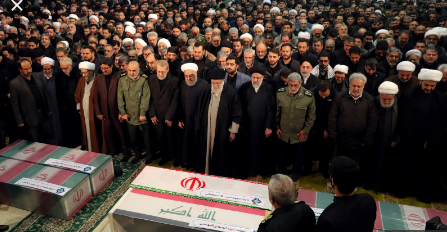Sunni and Shia are the two main sub-groups of Islam. Sunni and Shia share the most of the fundamental Islamic beliefs and articles of faith. The emergence of these two sub-groups can be traced way back to 623 A.D, when the Islamic Prophet Muhammad died. The death of Prophet Muhammad occasioned a debate as to who should be his true successor. The Majority believed that his rightful successor was his father-in-law and close friend, Abu Bakr Siddique, on the other hand, the minority group believed the rightful successor should be Ali ibn Abi Talib, his cousin and son-in-law and father of his grandchildren.
Though the divide was initially political in nature, the majority got their way and Abu Bakr became the first Muslim Caliph and successor of Prophet Muhammad. Well, over the centuries, as the minority group continued to support and acknowledge the power of Ali ibn Abi Talib; the divide eventually herald a number of varying practices and positions which came to carry spiritual significance and consequently resulting to evolution of the two religious movements, Sunni who are the majority and the Shia who are the minority.
In as far as the Islamic literature is concerned, Shia give more importance to specific Hadith and Sunna literature, leaning towards those that were written by family and close associates of the Prophet. Sunni however, gives more importance to all Islamic literature. This has further resulted to different understanding and interpretation of the Islamic law between the Shia and Sunni. For example, in Sunni Islam, the interpretation of Islamic law follows four principle schools of thought, which include: Hanafi, the Maliki, the Shafi’i and the Hanbali whereas the interpretation of Islamic law in Shia Islam follows one principle school of thought referred to as Jafariya.
More importantly, today Saudi Arabia and Iran are the two leading powers of the two sub-groups of Islam. The heart of Sunni Islam is Saudi Arabia, the birth place of Islam whereas the heart of Shia Islam is Iran. In this regard, Iran has national policies that support Shia political parties and Shia militant groups in other countries. Saudi Arabia has often perceived this as a threat to the well-being of Sunni and has with the help of United States Of America (USA) equally responded by increasing funding to Sunni interests everywhere.
What You Need To Know About Sunni Muslims

- In terms of size, Sunni Muslims are the largest group of adherents within Islam. Approximately 85% (1.5 billion) of Muslims around the world come from Sunni heritage.
- Sunni are predominantly found in Saudi Arabia, UAE, Egypt, Kuwait, Sudan, Yemen, Pakistan, Indonesia, Turkey, Algeria, Morocco, Nigeria, Chad and Tunisia.
- Sunni Muslims follow the many Hadith that are considered authenticated sayings of Prophet Muhammad to help interpret the Qur’an.
- When Sunnis pray, they kneel so that their head touches their prayer mat.
- Sunni believe strongly on the Five Pillars of Islam that is Shahadah (Faith), Prayer, Zakat (Charity), Fasting and Pilgrimage.
- In Sunni Islam, there is no concept of temporary marriages and they consider it a great sin.
- For Sunni, the mosque and Eidgah are the only places to worship ALLAH.
- Makkah and Madina in Saudi Arabia are considered holy places (Pilgrimage sites) by the Sunni Muslims and they have a strong affiliation to these places.
- In Sunni Islam, the interpretation of Islamic law follows four principle schools of thought, which include: Hanafi, the Maliki, the Shafi’i and the Hanbali
- In Sunni Islam, Imams or Caliph (as they say) are not regarded as free from sin (faultless). They are also not revered upon death as is the case with the Shia. Sunni consider this as blasphemous and equivalent to worshipping other deities.
- In Sunni Muslims, Imams or Caliph are considered as important religious leaders; however, the Imams can either be elected or nominated by the preceding caliph or selected by a committee.
- According to the beliefs of Sunni, there are four rightly guided (reliable) Caliphs/Imams: Abu Bakr, Umar bin Al Khattab, Usman bin Afan and Ali bin Abi Talib.
- An established formal hierarchy among the clergy and taxation does not exist in Sunni Islam because it is the majority religion in many places; the state often finances their religious institutions.
What You Need To Know About Shia Muslims

- In terms of size, Shia Muslims are the minority group of adherents within Islam. Approximately 15% (250 million) of Muslims around the world come from Shia heritage.
- Shia are predominantly found in Iran, Iraq, Syria, Lebanon, Bahrain, Azerbaijan and Yemen.
- Shia Muslim do not accept the authority of the six major Hadith collections of the Sunni Islam but instead follow the three Hadith they refer to as the Three Muhammads.
- When Shias pray, they kneel so that their head touches bare earth or a small clay block taken from a holy place.
- Shia believe strongly on the five pillars of Islam but in addition, they have five more unique principle pillars which include Tawhid (the Oneness of God), Nubuwwah (Prophethood), Resurrection, Divine Justice and Imamah (belief in the political and spiritual supremacy of the Prophet’s successors).
- In Shia Islam, there is the concept of temporary marriage commonly referred to as nikah mut’ah.
- For Shia, the places reserved for worship of ALLAH are Imambargah or Ashurkhana, Mosque and Eidgah.
- Kufa or Kufah city, which is located on the banks of the Euphrates River in Iraq and Kerbala or Karbala city in Central Iraq are considered as holy places (pilgrimage sites) by the Shia Muslims and they have a strong affiliation to these places.
- Shia Muslims follow one principal school of thought referred to as Jafariya in the interpretation of Islamic laws.
- Shia believes that the Imams exist to provide moral and religious leadership to the world. They are considered as religious leader free from sin (faultless) and are revered upon death. Shia followers visit and honor shrines of past imams, saints and scholars.
- In Shia Muslims, Imams are considered sinless/faultless as they are the immediate descendants of Prophet Muhammad. Therefore, Shia Imams taken to have been chosen by ALLAH himself.
- According to the beliefs of Shia, there are twelve rightly guided (reliable) Imams. They include Muhammad AlMahdi, Muhammad AlTaqi, Hassan AlAskari, Ali AlNaqi, Ali AlRaza, Musa Alkaazim, Muhammad AlBaqir, Ali ZainulAbideen, Jaafar Alsaadiq, Hussain Hassan, Ali ZainulAbideen and Ali bin Abi Talib.
- Shias have an established formal hierarchy among their clergy and they fund their religious institutions through a mandatory tax.
Difference Between Sunni And Shia In Tabular Form
| BASIS OF COMAPRIOSN | SUNNI MUSLIM | SHIA MUSLIM |
| Number | Sunni Muslims are the largest group of adherents within Islam. Approximately 85% (1.5 billion) of Muslims around the world come from Sunni heritage. | Shia Muslims are the minority group of adherents within Islam. Approximately 15% (250 million) of Muslims around the world come from Shia heritage. |
| Countries Of Dominance | Saudi Arabia, UAE, Egypt, Kuwait, Sudan, Yemen, Pakistan, Indonesia, Turkey, Algeria, Morocco, Nigeria, Chad and Tunisia. | Iran, Iraq, Syria, Lebanon, Bahrain, Azerbaijan and Yemen. |
| Hadith | Sunni Muslims follow the many Hadith that are considered authenticated sayings of Prophet Muhammad to help interpret the Qur’an. | Shia Muslim do not accept the authority of the six major Hadith collections of the Sunni Islam but instead follow the three Hadith they refer to as the Three Muhammads. |
| Praying | When Sunnis pray, they kneel so that their head touches their prayer mat. | When Shias pray, they kneel so that their head touches bare earth or a small clay block taken from a holy place. |
| Pillars Of Islam | Sunni believe strongly on the Five Pillars of Islam that is Shahadah (Faith), Prayer, Zakat (Charity), Fasting and Pilgrimage. | Shia believe strongly on the five pillars of Islam but in addition, they have five more unique principle pillars which include Tawhid (the Oneness of God), Nubuwwah (Prophethood), Resurrection, Divine Justice and Imamah (belief in the political and spiritual supremacy of the Prophet’s successors). |
| Concept Of Temporary Marriage | In Sunni Islam, there is no concept of temporary marriages and they consider it a great sin. | In Shia Islam, there is the concept of temporary marriage commonly referred to as nikah mut’ah. |
| Place Of Worship | For Sunni, the mosque and Eidgah are the only places to worship ALLAH. | For Shia, the places reserved for worship of ALLAH are Imambargah or Ashurkhana, Mosque and Eidgah. |
| Principle Schools Of Thought In Interpretation Of Islamic laws | In Sunni Islam, the interpretation of Islamic law follows four principle schools of thought, which include: Hanafi, the Maliki, the Shafi’i and the Hanbali | Shia Muslims follow one principal school of thought referred to as Jafariya in the interpretation of Islamic laws. |
| Imams | In Sunni Islam, Imams or Caliph (as they say) are not regarded as free from sin (faultless). They are also not revered upon death as is the case with the Shia. Sunni consider this as blasphemous and equivalent to worshipping other deities. | Shia believes that the Imams exist to provide moral and religious leadership to the world. They are considered as religious leader free from sin (faultless) and are revered upon death. Shia followers visit and honor shrines of past imams, saints and scholars. |
| Appointment Of Imams | In Sunni Muslims, Imams or Caliph are considered as important religious leaders; however, the Imams can either be elected or nominated by the preceding caliph or selected by a committee. | In Shia Muslims, Imams are considered sinless/faultless as they are the immediate descendants of Prophet Muhammad. Therefore, Shia Imams taken to have been chosen by ALLAH himself. |
| Reliable (Rightly Guided Imams) | According to the beliefs of Sunni, there are four rightly guided (reliable) Caliphs/Imams: Abu Bakr, Umar bin Al Khattab, Usman bin Afan and Ali bin Abi Talib. | According to the beliefs of Shia, there are twelve rightly guided (reliable) Imams. They include Muhammad AlMahdi, Muhammad AlTaqi, Hassan AlAskari, Ali AlNaqi, Ali AlRaza, Musa Alkaazim, Muhammad AlBaqir, Ali ZainulAbideen, Jaafar Alsaadiq, Hussain Hassan, Ali ZainulAbideen and Ali bin Abi Talib. |
| Formal Clergy Hierarchy And Taxation | An established hierarchy among the clergy and taxation does not exist in Sunni Islam because it is the majority religion in many places; the state often finances their religious institutions. | Shias have an established formal hierarchy among their clergy and they fund their religious institutions through a mandatory tax. |
What Are Some Of The Similarities Between Shia And Sunni?
- Both Sunni and Shia Islam accept the Muslim teaching that Jesus is one among the many Prophets in Islam.
- Spiritually, both groups practice the Five Pillars of Islam that is Shahadah (Faith), Prayer, Zakat (Charity), Fasting and Pilgrimage.
- Both Shia and Sunni observe the Day of Ashura. Ashura is the tenth day of Muharram, the first month in the Islamic calendar. It marks the day that Husayn ibn Ali, the grandson of Prophet Muhammad was martyred in the Battle of Karbala.
- They Sunni and Shia, agree on the major elements of faith that is, belief in one God, Devils, Demons, Angels, Prophets, Qur’an and life after death.
- Both Shia and Sunni believe that the purpose of human life is to praise God so that one day the gates of heaven (paradise) will open for them.